MN7510 Managing Information: A Critical Review of CRM Technology
VerifiedAdded on 2023/04/21
|18
|5298
|133
Essay
AI Summary
This essay provides a critical assessment of the implications arising from the implementation of Customer Relations Management (CRM) technologies. It begins by defining CRM and its various types, including on-premises, cloud-based, and open-source CRM. The essay then details the six key steps involved in CRM implementation: technology review and selection, project management and communication, vendor contracting and software licensing, CRM system customization, data migration, and training and support. Furthermore, the essay explores significant implications of CRM implementation such as data capturing, data mining and better market segmentation. Theories like ANT, representation, Baudrillard, LPT, and systems theory could be applied to analyze these implications. The document is contributed by a student and available on Desklib, a platform offering study tools and resources.
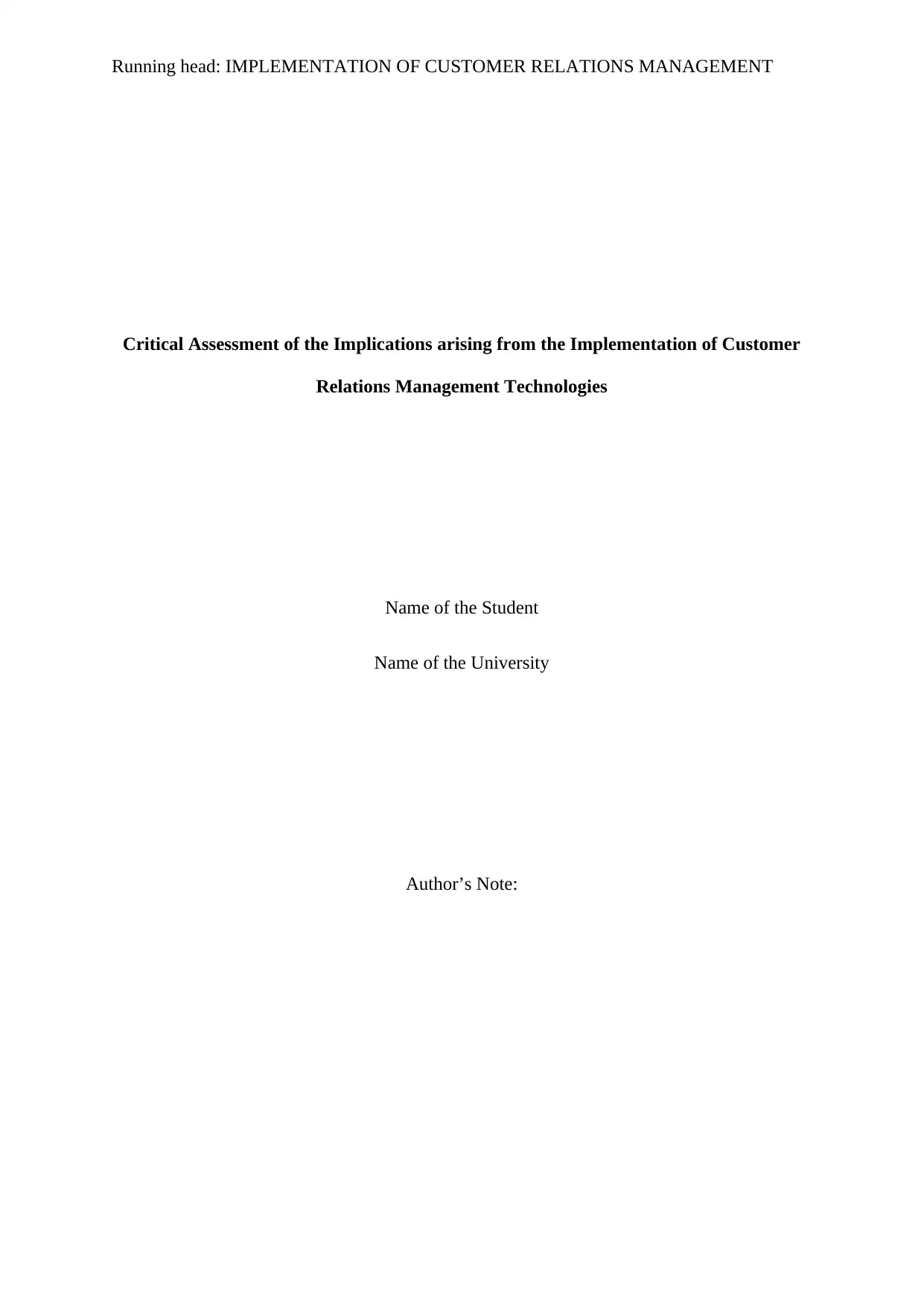
Running head: IMPLEMENTATION OF CUSTOMER RELATIONS MANAGEMENT
Critical Assessment of the Implications arising from the Implementation of Customer
Relations Management Technologies
Name of the Student
Name of the University
Author’s Note:
Critical Assessment of the Implications arising from the Implementation of Customer
Relations Management Technologies
Name of the Student
Name of the University
Author’s Note:
Paraphrase This Document
Need a fresh take? Get an instant paraphrase of this document with our AI Paraphraser
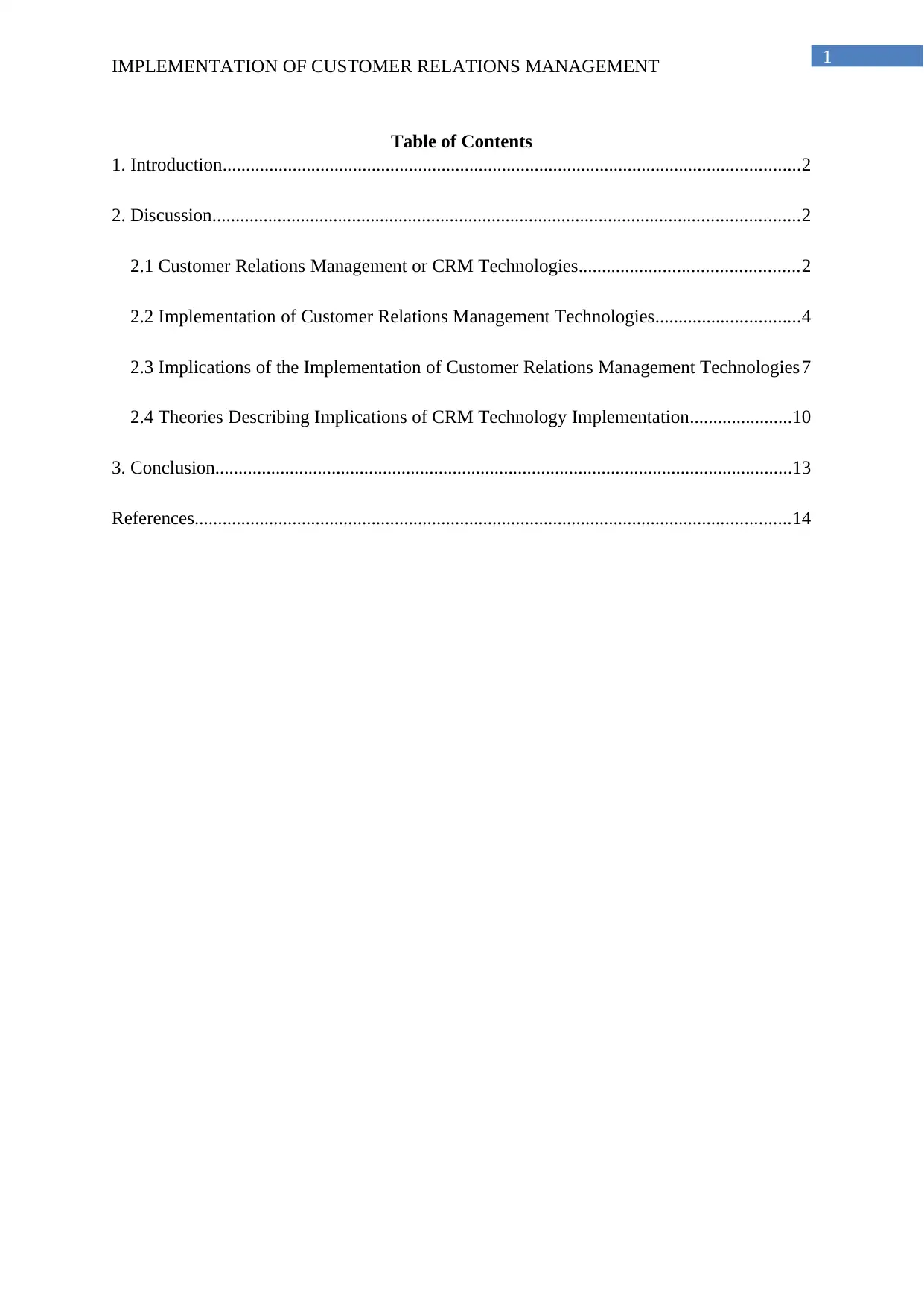
1
IMPLEMENTATION OF CUSTOMER RELATIONS MANAGEMENT
Table of Contents
1. Introduction............................................................................................................................2
2. Discussion..............................................................................................................................2
2.1 Customer Relations Management or CRM Technologies...............................................2
2.2 Implementation of Customer Relations Management Technologies...............................4
2.3 Implications of the Implementation of Customer Relations Management Technologies7
2.4 Theories Describing Implications of CRM Technology Implementation......................10
3. Conclusion............................................................................................................................13
References................................................................................................................................14
IMPLEMENTATION OF CUSTOMER RELATIONS MANAGEMENT
Table of Contents
1. Introduction............................................................................................................................2
2. Discussion..............................................................................................................................2
2.1 Customer Relations Management or CRM Technologies...............................................2
2.2 Implementation of Customer Relations Management Technologies...............................4
2.3 Implications of the Implementation of Customer Relations Management Technologies7
2.4 Theories Describing Implications of CRM Technology Implementation......................10
3. Conclusion............................................................................................................................13
References................................................................................................................................14

2
IMPLEMENTATION OF CUSTOMER RELATIONS MANAGEMENT
1. Introduction
CRM or customer relations management can be stated as one of the most significant
approaches for the purpose of managing the interactions of an organization with the potential
and current customers (Khodakarami & Chan, 2014). This particular approach utilizes
analysis of data concerning history of each and every customer with the specific organization
for improving business relationship with these customers after focusing on the growth of
sales and customer retention. The software of CRM eventually consolidates the information
or documents of customers within one CRM database and hence the business users could
easily and promptly access or manage those (Choudhury & Harrigan, 2014). The following
report outlines a brief discussion on the major implications that arise from the
implementation of customer relations management technologies with relevant details.
2. Discussion
2.1 Customer Relations Management or CRM Technologies
CRM technology is being used for the better management of each and every
interaction or relation of a specific organization with its customers (Nyadzayo &
Khajehzadeh, 2016). The major goal of this type of technology is to improvise the respective
business relationships and provides other benefits like improving profitability, streamlining
of business processes and staying connected to customers. The management of organizational
sales is also easily done with customer relations management technology. This particular
solution helps in focusing on the organizational relations with other people like suppliers,
vendors, customers and anyone connected with the company (Trainor et al., 2014). Regarding
marketing of the company, CRM technology is quite useful for storing as well as prospecting
the customer information, identification of sales opportunities, recording the service issues
and even management of marketing campaigns without any type of complexity.
IMPLEMENTATION OF CUSTOMER RELATIONS MANAGEMENT
1. Introduction
CRM or customer relations management can be stated as one of the most significant
approaches for the purpose of managing the interactions of an organization with the potential
and current customers (Khodakarami & Chan, 2014). This particular approach utilizes
analysis of data concerning history of each and every customer with the specific organization
for improving business relationship with these customers after focusing on the growth of
sales and customer retention. The software of CRM eventually consolidates the information
or documents of customers within one CRM database and hence the business users could
easily and promptly access or manage those (Choudhury & Harrigan, 2014). The following
report outlines a brief discussion on the major implications that arise from the
implementation of customer relations management technologies with relevant details.
2. Discussion
2.1 Customer Relations Management or CRM Technologies
CRM technology is being used for the better management of each and every
interaction or relation of a specific organization with its customers (Nyadzayo &
Khajehzadeh, 2016). The major goal of this type of technology is to improvise the respective
business relationships and provides other benefits like improving profitability, streamlining
of business processes and staying connected to customers. The management of organizational
sales is also easily done with customer relations management technology. This particular
solution helps in focusing on the organizational relations with other people like suppliers,
vendors, customers and anyone connected with the company (Trainor et al., 2014). Regarding
marketing of the company, CRM technology is quite useful for storing as well as prospecting
the customer information, identification of sales opportunities, recording the service issues
and even management of marketing campaigns without any type of complexity.
⊘ This is a preview!⊘
Do you want full access?
Subscribe today to unlock all pages.

Trusted by 1+ million students worldwide

3
IMPLEMENTATION OF CUSTOMER RELATIONS MANAGEMENT
With the easier access and visibility of data in CRM technologies, it becomes quite
easy to collaborate and then increase the productivity. These technologies could even be
helpful to the companies of every size to drive business growth and hence it could be
specifically advantageous to smaller businesses, in which the teams often require to find out
ways for doing less (Badwan et al., 2017). The customer service issues are better managed
and thus status of the orders are being checked easily. There are various types of customer
relations management technology and for them, four most popular and significant vendors are
Oracle, SAP, Microsoft and Salesforce. The remaining vendors are being used mainly by the
smaller and medium sized enterprises or SMEs, however, these above mentioned four
technologies are used by the larger organizations.
The major types of customer relations management technologies are given below:
i) On Premises CRM: The first and the foremost type of customer relations
management technology is the on premises customer relations management (Hassan et al.,
2015). This particular system puts an obligation of the administrations, security, maintenance
and control of database as well as information over the organization with the help of the
software of CRM. With this specified approach, the respective organization eventually
purchases the licenses up front instead of getting annual subscription from the cloud based
CRM provider. This CRM software exists over the organizational own servers and that user
subsequently assumes about the expenses of up gradations. The on premises CRM also needs
a prolonged installation procedure for the completed integration of company’s data (Soltani
& Navimipour, 2016). The organizations with the most complex CRM requirements, might
obtain advantages from the deployment of an on premises software.
ii) Cloud Based CRM: The second important and significant type of CRM technology
is the cloud based CRM. The other names of cloud based customer relations management are
IMPLEMENTATION OF CUSTOMER RELATIONS MANAGEMENT
With the easier access and visibility of data in CRM technologies, it becomes quite
easy to collaborate and then increase the productivity. These technologies could even be
helpful to the companies of every size to drive business growth and hence it could be
specifically advantageous to smaller businesses, in which the teams often require to find out
ways for doing less (Badwan et al., 2017). The customer service issues are better managed
and thus status of the orders are being checked easily. There are various types of customer
relations management technology and for them, four most popular and significant vendors are
Oracle, SAP, Microsoft and Salesforce. The remaining vendors are being used mainly by the
smaller and medium sized enterprises or SMEs, however, these above mentioned four
technologies are used by the larger organizations.
The major types of customer relations management technologies are given below:
i) On Premises CRM: The first and the foremost type of customer relations
management technology is the on premises customer relations management (Hassan et al.,
2015). This particular system puts an obligation of the administrations, security, maintenance
and control of database as well as information over the organization with the help of the
software of CRM. With this specified approach, the respective organization eventually
purchases the licenses up front instead of getting annual subscription from the cloud based
CRM provider. This CRM software exists over the organizational own servers and that user
subsequently assumes about the expenses of up gradations. The on premises CRM also needs
a prolonged installation procedure for the completed integration of company’s data (Soltani
& Navimipour, 2016). The organizations with the most complex CRM requirements, might
obtain advantages from the deployment of an on premises software.
ii) Cloud Based CRM: The second important and significant type of CRM technology
is the cloud based CRM. The other names of cloud based customer relations management are
Paraphrase This Document
Need a fresh take? Get an instant paraphrase of this document with our AI Paraphraser
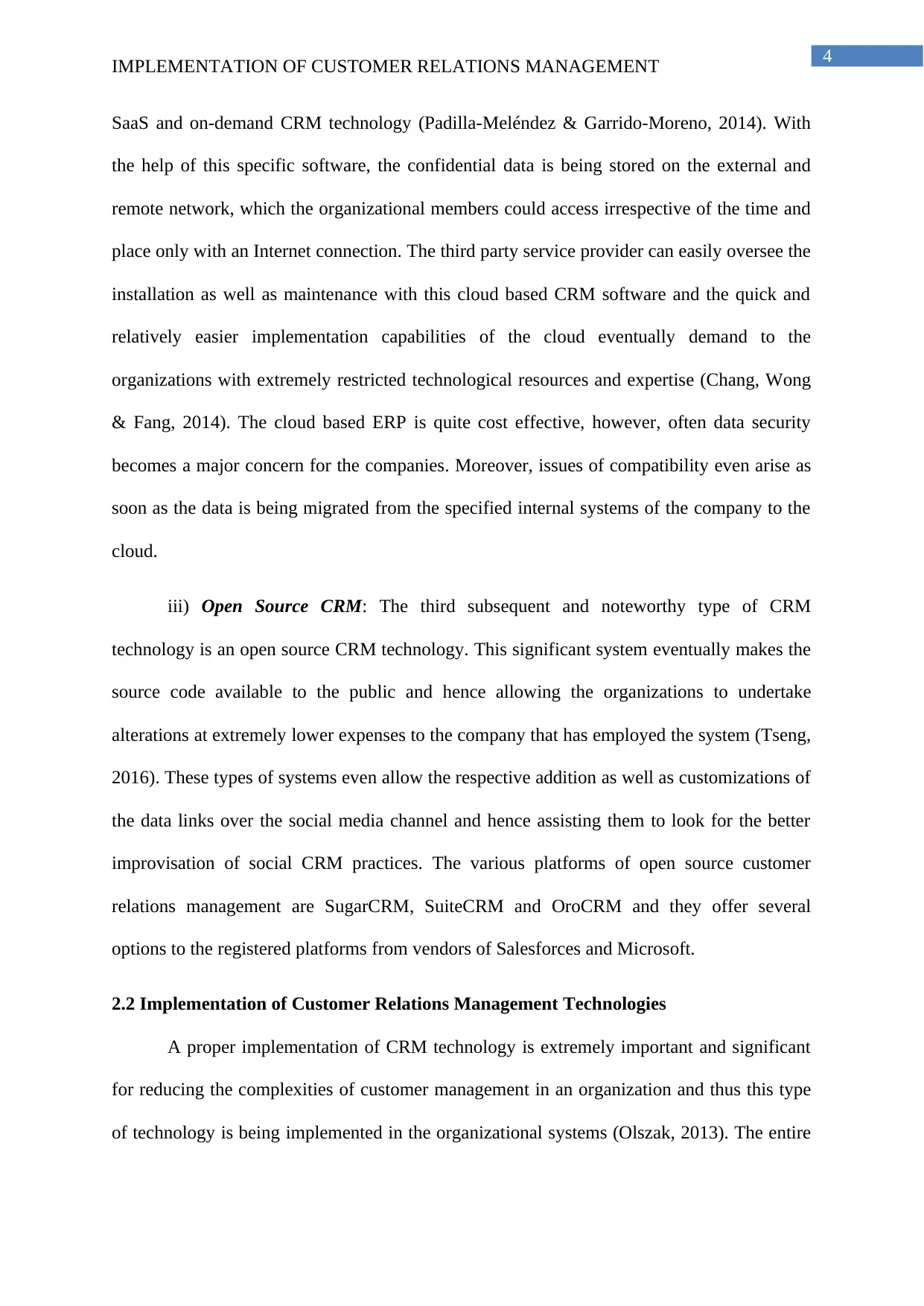
4
IMPLEMENTATION OF CUSTOMER RELATIONS MANAGEMENT
SaaS and on-demand CRM technology (Padilla-Meléndez & Garrido-Moreno, 2014). With
the help of this specific software, the confidential data is being stored on the external and
remote network, which the organizational members could access irrespective of the time and
place only with an Internet connection. The third party service provider can easily oversee the
installation as well as maintenance with this cloud based CRM software and the quick and
relatively easier implementation capabilities of the cloud eventually demand to the
organizations with extremely restricted technological resources and expertise (Chang, Wong
& Fang, 2014). The cloud based ERP is quite cost effective, however, often data security
becomes a major concern for the companies. Moreover, issues of compatibility even arise as
soon as the data is being migrated from the specified internal systems of the company to the
cloud.
iii) Open Source CRM: The third subsequent and noteworthy type of CRM
technology is an open source CRM technology. This significant system eventually makes the
source code available to the public and hence allowing the organizations to undertake
alterations at extremely lower expenses to the company that has employed the system (Tseng,
2016). These types of systems even allow the respective addition as well as customizations of
the data links over the social media channel and hence assisting them to look for the better
improvisation of social CRM practices. The various platforms of open source customer
relations management are SugarCRM, SuiteCRM and OroCRM and they offer several
options to the registered platforms from vendors of Salesforces and Microsoft.
2.2 Implementation of Customer Relations Management Technologies
A proper implementation of CRM technology is extremely important and significant
for reducing the complexities of customer management in an organization and thus this type
of technology is being implemented in the organizational systems (Olszak, 2013). The entire
IMPLEMENTATION OF CUSTOMER RELATIONS MANAGEMENT
SaaS and on-demand CRM technology (Padilla-Meléndez & Garrido-Moreno, 2014). With
the help of this specific software, the confidential data is being stored on the external and
remote network, which the organizational members could access irrespective of the time and
place only with an Internet connection. The third party service provider can easily oversee the
installation as well as maintenance with this cloud based CRM software and the quick and
relatively easier implementation capabilities of the cloud eventually demand to the
organizations with extremely restricted technological resources and expertise (Chang, Wong
& Fang, 2014). The cloud based ERP is quite cost effective, however, often data security
becomes a major concern for the companies. Moreover, issues of compatibility even arise as
soon as the data is being migrated from the specified internal systems of the company to the
cloud.
iii) Open Source CRM: The third subsequent and noteworthy type of CRM
technology is an open source CRM technology. This significant system eventually makes the
source code available to the public and hence allowing the organizations to undertake
alterations at extremely lower expenses to the company that has employed the system (Tseng,
2016). These types of systems even allow the respective addition as well as customizations of
the data links over the social media channel and hence assisting them to look for the better
improvisation of social CRM practices. The various platforms of open source customer
relations management are SugarCRM, SuiteCRM and OroCRM and they offer several
options to the registered platforms from vendors of Salesforces and Microsoft.
2.2 Implementation of Customer Relations Management Technologies
A proper implementation of CRM technology is extremely important and significant
for reducing the complexities of customer management in an organization and thus this type
of technology is being implemented in the organizational systems (Olszak, 2013). The entire

5
IMPLEMENTATION OF CUSTOMER RELATIONS MANAGEMENT
process of CRM technology implementation is not complicated and it comprises of six
distinctive steps. These six steps are as follows:
i) CRM Technology Review and Selection: The first and the foremost step in this
process of implementation of CRM technology is the proper reviewing and selection of CRM
technology. Since, there are a variety of CRM technologies, it is extremely important and
significant to select the most appropriate technology (Abdul, Basri & Shaharuddin, 2013).
The suitable CRM system is vital for the perfect maintenance of timely as well as cost
effective project. The respective companies should even have gone through the process of
selection and implementation of customer relations management. Furthermore, they offer
valuable advices regarding the tools, which are being reviewed and then a correct technology
is selected.
ii) Project Management and Communication: The second important and significant
step in this process of implementation of CRM technology is the management of project. The
deployment of CRM system could be extremely expensive and time consuming procedure
with several elements that occur in simultaneous manner (Payne & Frow, 2013). Ensuring
stronger project management and then following a specific detailed strategy of
communication for the core purpose of helping to keep every participant is being informed of
their responsibilities. The making of communication strategy is quite vital since it helps to
maintain a proper communication within the organizational management and organizational
members. The vendor of customer relations management and the organization has to follow
this step.
iii) Vendor Contracting as well as Software Licensing: The third subsequent and
noteworthy step in this process of implementation of CRM technology is the contracting as
well as software licensing of the respective vendors. As soon as the most suitable CRM
IMPLEMENTATION OF CUSTOMER RELATIONS MANAGEMENT
process of CRM technology implementation is not complicated and it comprises of six
distinctive steps. These six steps are as follows:
i) CRM Technology Review and Selection: The first and the foremost step in this
process of implementation of CRM technology is the proper reviewing and selection of CRM
technology. Since, there are a variety of CRM technologies, it is extremely important and
significant to select the most appropriate technology (Abdul, Basri & Shaharuddin, 2013).
The suitable CRM system is vital for the perfect maintenance of timely as well as cost
effective project. The respective companies should even have gone through the process of
selection and implementation of customer relations management. Furthermore, they offer
valuable advices regarding the tools, which are being reviewed and then a correct technology
is selected.
ii) Project Management and Communication: The second important and significant
step in this process of implementation of CRM technology is the management of project. The
deployment of CRM system could be extremely expensive and time consuming procedure
with several elements that occur in simultaneous manner (Payne & Frow, 2013). Ensuring
stronger project management and then following a specific detailed strategy of
communication for the core purpose of helping to keep every participant is being informed of
their responsibilities. The making of communication strategy is quite vital since it helps to
maintain a proper communication within the organizational management and organizational
members. The vendor of customer relations management and the organization has to follow
this step.
iii) Vendor Contracting as well as Software Licensing: The third subsequent and
noteworthy step in this process of implementation of CRM technology is the contracting as
well as software licensing of the respective vendors. As soon as the most suitable CRM
⊘ This is a preview!⊘
Do you want full access?
Subscribe today to unlock all pages.

Trusted by 1+ million students worldwide
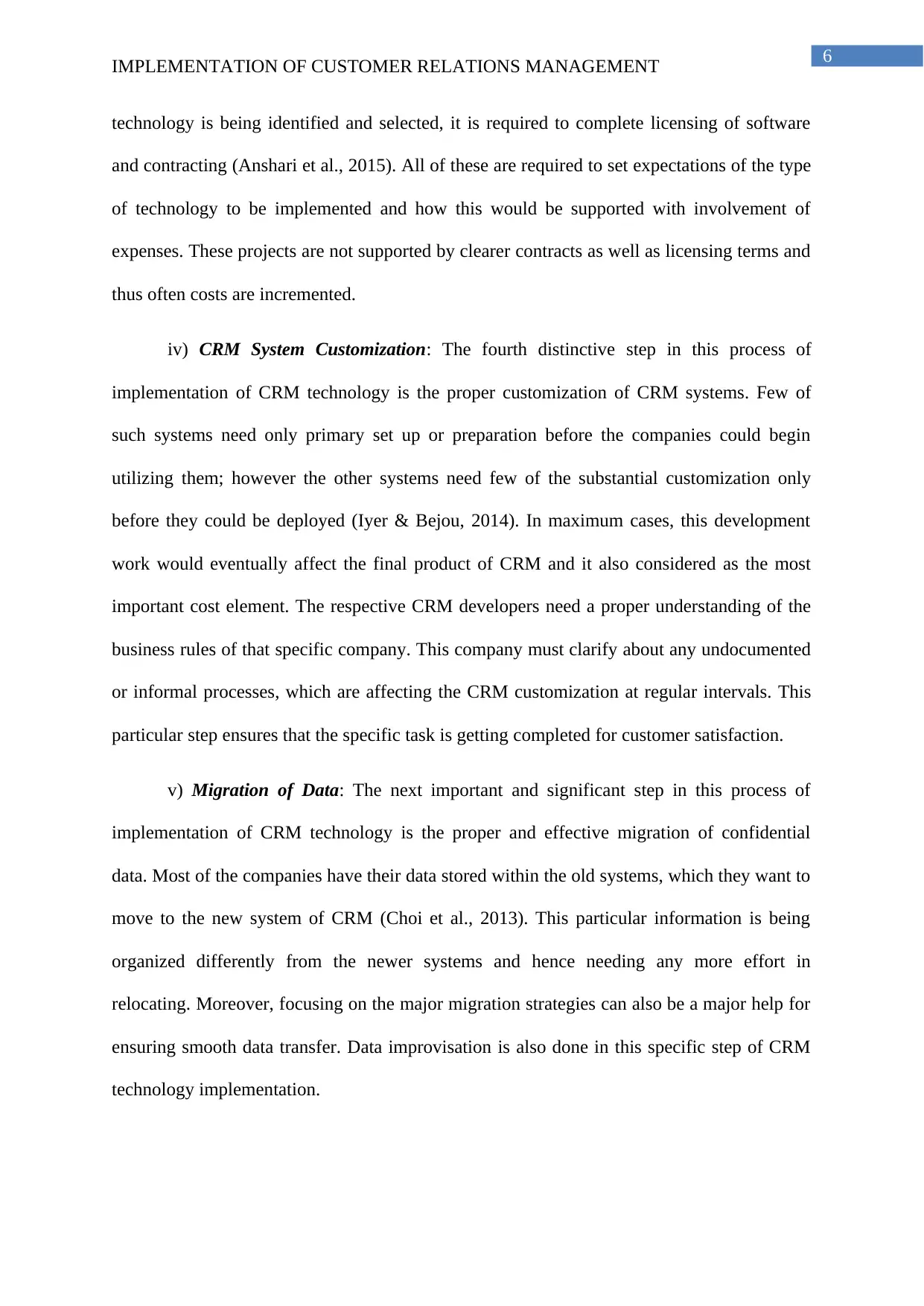
6
IMPLEMENTATION OF CUSTOMER RELATIONS MANAGEMENT
technology is being identified and selected, it is required to complete licensing of software
and contracting (Anshari et al., 2015). All of these are required to set expectations of the type
of technology to be implemented and how this would be supported with involvement of
expenses. These projects are not supported by clearer contracts as well as licensing terms and
thus often costs are incremented.
iv) CRM System Customization: The fourth distinctive step in this process of
implementation of CRM technology is the proper customization of CRM systems. Few of
such systems need only primary set up or preparation before the companies could begin
utilizing them; however the other systems need few of the substantial customization only
before they could be deployed (Iyer & Bejou, 2014). In maximum cases, this development
work would eventually affect the final product of CRM and it also considered as the most
important cost element. The respective CRM developers need a proper understanding of the
business rules of that specific company. This company must clarify about any undocumented
or informal processes, which are affecting the CRM customization at regular intervals. This
particular step ensures that the specific task is getting completed for customer satisfaction.
v) Migration of Data: The next important and significant step in this process of
implementation of CRM technology is the proper and effective migration of confidential
data. Most of the companies have their data stored within the old systems, which they want to
move to the new system of CRM (Choi et al., 2013). This particular information is being
organized differently from the newer systems and hence needing any more effort in
relocating. Moreover, focusing on the major migration strategies can also be a major help for
ensuring smooth data transfer. Data improvisation is also done in this specific step of CRM
technology implementation.
IMPLEMENTATION OF CUSTOMER RELATIONS MANAGEMENT
technology is being identified and selected, it is required to complete licensing of software
and contracting (Anshari et al., 2015). All of these are required to set expectations of the type
of technology to be implemented and how this would be supported with involvement of
expenses. These projects are not supported by clearer contracts as well as licensing terms and
thus often costs are incremented.
iv) CRM System Customization: The fourth distinctive step in this process of
implementation of CRM technology is the proper customization of CRM systems. Few of
such systems need only primary set up or preparation before the companies could begin
utilizing them; however the other systems need few of the substantial customization only
before they could be deployed (Iyer & Bejou, 2014). In maximum cases, this development
work would eventually affect the final product of CRM and it also considered as the most
important cost element. The respective CRM developers need a proper understanding of the
business rules of that specific company. This company must clarify about any undocumented
or informal processes, which are affecting the CRM customization at regular intervals. This
particular step ensures that the specific task is getting completed for customer satisfaction.
v) Migration of Data: The next important and significant step in this process of
implementation of CRM technology is the proper and effective migration of confidential
data. Most of the companies have their data stored within the old systems, which they want to
move to the new system of CRM (Choi et al., 2013). This particular information is being
organized differently from the newer systems and hence needing any more effort in
relocating. Moreover, focusing on the major migration strategies can also be a major help for
ensuring smooth data transfer. Data improvisation is also done in this specific step of CRM
technology implementation.
Paraphrase This Document
Need a fresh take? Get an instant paraphrase of this document with our AI Paraphraser
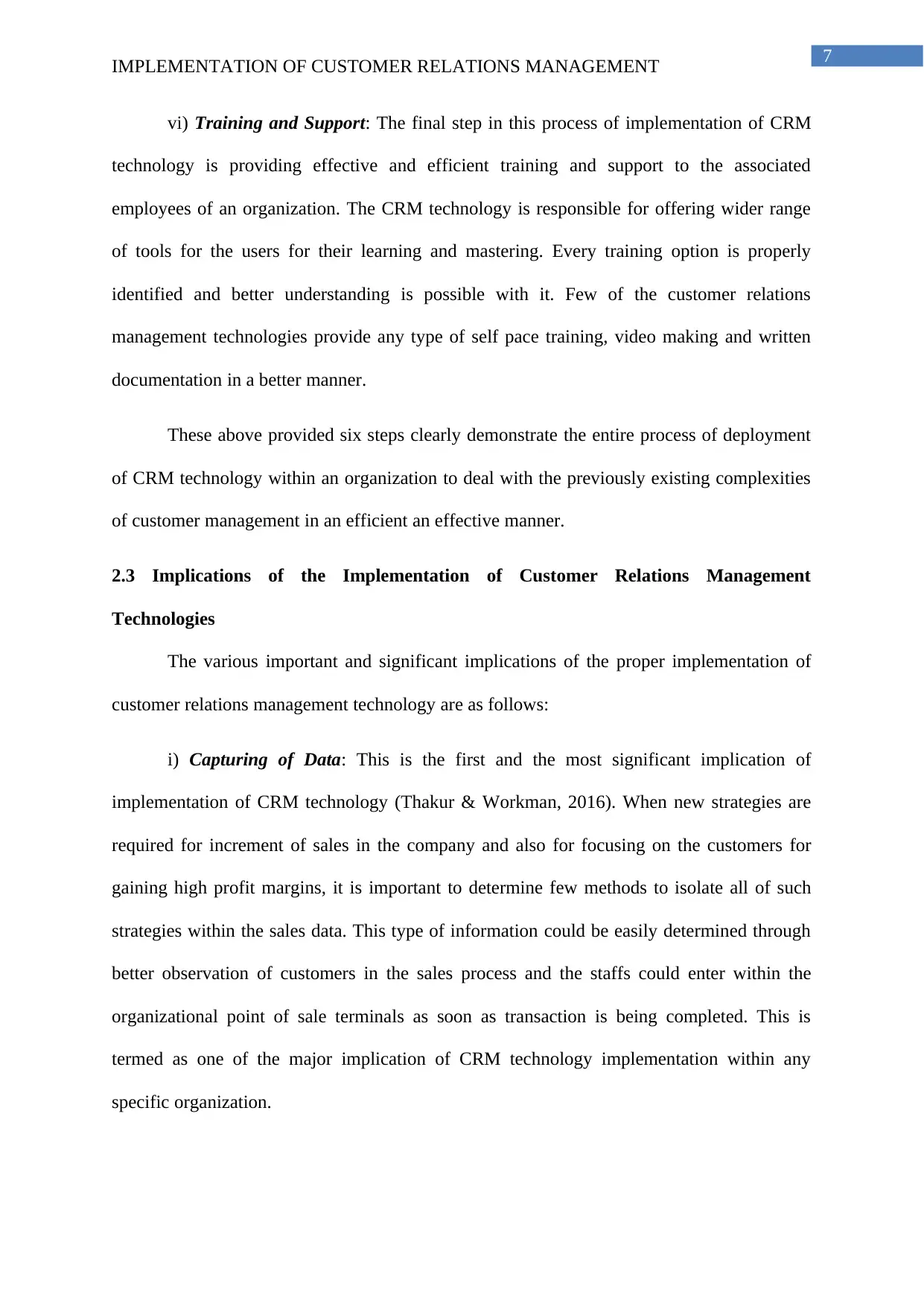
7
IMPLEMENTATION OF CUSTOMER RELATIONS MANAGEMENT
vi) Training and Support: The final step in this process of implementation of CRM
technology is providing effective and efficient training and support to the associated
employees of an organization. The CRM technology is responsible for offering wider range
of tools for the users for their learning and mastering. Every training option is properly
identified and better understanding is possible with it. Few of the customer relations
management technologies provide any type of self pace training, video making and written
documentation in a better manner.
These above provided six steps clearly demonstrate the entire process of deployment
of CRM technology within an organization to deal with the previously existing complexities
of customer management in an efficient an effective manner.
2.3 Implications of the Implementation of Customer Relations Management
Technologies
The various important and significant implications of the proper implementation of
customer relations management technology are as follows:
i) Capturing of Data: This is the first and the most significant implication of
implementation of CRM technology (Thakur & Workman, 2016). When new strategies are
required for increment of sales in the company and also for focusing on the customers for
gaining high profit margins, it is important to determine few methods to isolate all of such
strategies within the sales data. This type of information could be easily determined through
better observation of customers in the sales process and the staffs could enter within the
organizational point of sale terminals as soon as transaction is being completed. This is
termed as one of the major implication of CRM technology implementation within any
specific organization.
IMPLEMENTATION OF CUSTOMER RELATIONS MANAGEMENT
vi) Training and Support: The final step in this process of implementation of CRM
technology is providing effective and efficient training and support to the associated
employees of an organization. The CRM technology is responsible for offering wider range
of tools for the users for their learning and mastering. Every training option is properly
identified and better understanding is possible with it. Few of the customer relations
management technologies provide any type of self pace training, video making and written
documentation in a better manner.
These above provided six steps clearly demonstrate the entire process of deployment
of CRM technology within an organization to deal with the previously existing complexities
of customer management in an efficient an effective manner.
2.3 Implications of the Implementation of Customer Relations Management
Technologies
The various important and significant implications of the proper implementation of
customer relations management technology are as follows:
i) Capturing of Data: This is the first and the most significant implication of
implementation of CRM technology (Thakur & Workman, 2016). When new strategies are
required for increment of sales in the company and also for focusing on the customers for
gaining high profit margins, it is important to determine few methods to isolate all of such
strategies within the sales data. This type of information could be easily determined through
better observation of customers in the sales process and the staffs could enter within the
organizational point of sale terminals as soon as transaction is being completed. This is
termed as one of the major implication of CRM technology implementation within any
specific organization.

8
IMPLEMENTATION OF CUSTOMER RELATIONS MANAGEMENT
ii) Data Mining: The second significant implication of CRM technology in any
organization is data mining. New strategies are being used for the purpose of incrementing
the sales and even for focusing on the customers on the items with higher profit margins
(Rahimi & Gunlu, 2016). After data is being captured successfully, this specific information
could be mined within the software of customer relations management for correlating the
sales initiatives with the most profitable tools and techniques. Data mining is considered as
one of the most important implications that helps in reducing the major complexities of data
management after data capturing. The customer impulses are much lower in this case and
hence it is quite popular for the larger organizations to maintain a better relation with their
customers.
iii) Better Market Segmentation: The third subsequent implication of CRM
technology is the better market segmentation. This particular software is helpful in gathering
information regarding the customers after inclusion of demographic and preference data. This
information can be useful for segmenting the market and even customization of the approach
to every customers’ group (Almunawar & Anshari, 2014). The effect of this segmentation on
the basis of CRM data is for the better adjustments of organizational strategies in better
suiting the clients.
iv) Improvement of Customer Retention: The next important and noteworthy
implication of the CRM technology is customer retention. The total effect of this software is
for incrementing the customer retention by properly serving them in a more convenient and
focused manner. The effect could even be incremented by utilizing the software of CRM for
implementing customer loyalty program (Law, Ennew & Mitussis, 2013). As the applications
can track the respective purchases, the organization could issue reward points as well as
bonuses in keeping the valuable customers. These programs even reduce expenses as sales
are cheaper than the sales to new customers.
IMPLEMENTATION OF CUSTOMER RELATIONS MANAGEMENT
ii) Data Mining: The second significant implication of CRM technology in any
organization is data mining. New strategies are being used for the purpose of incrementing
the sales and even for focusing on the customers on the items with higher profit margins
(Rahimi & Gunlu, 2016). After data is being captured successfully, this specific information
could be mined within the software of customer relations management for correlating the
sales initiatives with the most profitable tools and techniques. Data mining is considered as
one of the most important implications that helps in reducing the major complexities of data
management after data capturing. The customer impulses are much lower in this case and
hence it is quite popular for the larger organizations to maintain a better relation with their
customers.
iii) Better Market Segmentation: The third subsequent implication of CRM
technology is the better market segmentation. This particular software is helpful in gathering
information regarding the customers after inclusion of demographic and preference data. This
information can be useful for segmenting the market and even customization of the approach
to every customers’ group (Almunawar & Anshari, 2014). The effect of this segmentation on
the basis of CRM data is for the better adjustments of organizational strategies in better
suiting the clients.
iv) Improvement of Customer Retention: The next important and noteworthy
implication of the CRM technology is customer retention. The total effect of this software is
for incrementing the customer retention by properly serving them in a more convenient and
focused manner. The effect could even be incremented by utilizing the software of CRM for
implementing customer loyalty program (Law, Ennew & Mitussis, 2013). As the applications
can track the respective purchases, the organization could issue reward points as well as
bonuses in keeping the valuable customers. These programs even reduce expenses as sales
are cheaper than the sales to new customers.
⊘ This is a preview!⊘
Do you want full access?
Subscribe today to unlock all pages.

Trusted by 1+ million students worldwide
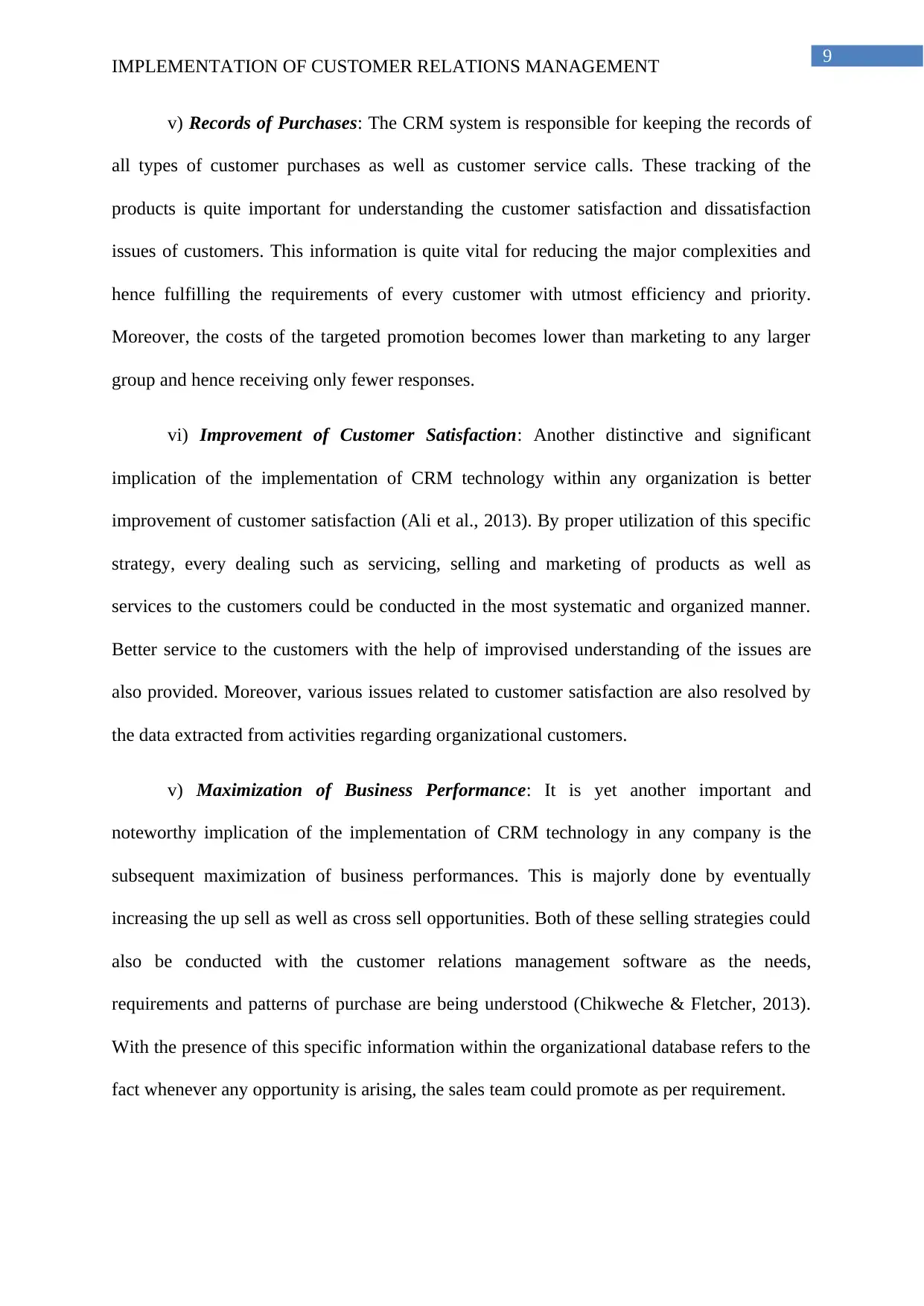
9
IMPLEMENTATION OF CUSTOMER RELATIONS MANAGEMENT
v) Records of Purchases: The CRM system is responsible for keeping the records of
all types of customer purchases as well as customer service calls. These tracking of the
products is quite important for understanding the customer satisfaction and dissatisfaction
issues of customers. This information is quite vital for reducing the major complexities and
hence fulfilling the requirements of every customer with utmost efficiency and priority.
Moreover, the costs of the targeted promotion becomes lower than marketing to any larger
group and hence receiving only fewer responses.
vi) Improvement of Customer Satisfaction: Another distinctive and significant
implication of the implementation of CRM technology within any organization is better
improvement of customer satisfaction (Ali et al., 2013). By proper utilization of this specific
strategy, every dealing such as servicing, selling and marketing of products as well as
services to the customers could be conducted in the most systematic and organized manner.
Better service to the customers with the help of improvised understanding of the issues are
also provided. Moreover, various issues related to customer satisfaction are also resolved by
the data extracted from activities regarding organizational customers.
v) Maximization of Business Performance: It is yet another important and
noteworthy implication of the implementation of CRM technology in any company is the
subsequent maximization of business performances. This is majorly done by eventually
increasing the up sell as well as cross sell opportunities. Both of these selling strategies could
also be conducted with the customer relations management software as the needs,
requirements and patterns of purchase are being understood (Chikweche & Fletcher, 2013).
With the presence of this specific information within the organizational database refers to the
fact whenever any opportunity is arising, the sales team could promote as per requirement.
IMPLEMENTATION OF CUSTOMER RELATIONS MANAGEMENT
v) Records of Purchases: The CRM system is responsible for keeping the records of
all types of customer purchases as well as customer service calls. These tracking of the
products is quite important for understanding the customer satisfaction and dissatisfaction
issues of customers. This information is quite vital for reducing the major complexities and
hence fulfilling the requirements of every customer with utmost efficiency and priority.
Moreover, the costs of the targeted promotion becomes lower than marketing to any larger
group and hence receiving only fewer responses.
vi) Improvement of Customer Satisfaction: Another distinctive and significant
implication of the implementation of CRM technology within any organization is better
improvement of customer satisfaction (Ali et al., 2013). By proper utilization of this specific
strategy, every dealing such as servicing, selling and marketing of products as well as
services to the customers could be conducted in the most systematic and organized manner.
Better service to the customers with the help of improvised understanding of the issues are
also provided. Moreover, various issues related to customer satisfaction are also resolved by
the data extracted from activities regarding organizational customers.
v) Maximization of Business Performance: It is yet another important and
noteworthy implication of the implementation of CRM technology in any company is the
subsequent maximization of business performances. This is majorly done by eventually
increasing the up sell as well as cross sell opportunities. Both of these selling strategies could
also be conducted with the customer relations management software as the needs,
requirements and patterns of purchase are being understood (Chikweche & Fletcher, 2013).
With the presence of this specific information within the organizational database refers to the
fact whenever any opportunity is arising, the sales team could promote as per requirement.
Paraphrase This Document
Need a fresh take? Get an instant paraphrase of this document with our AI Paraphraser
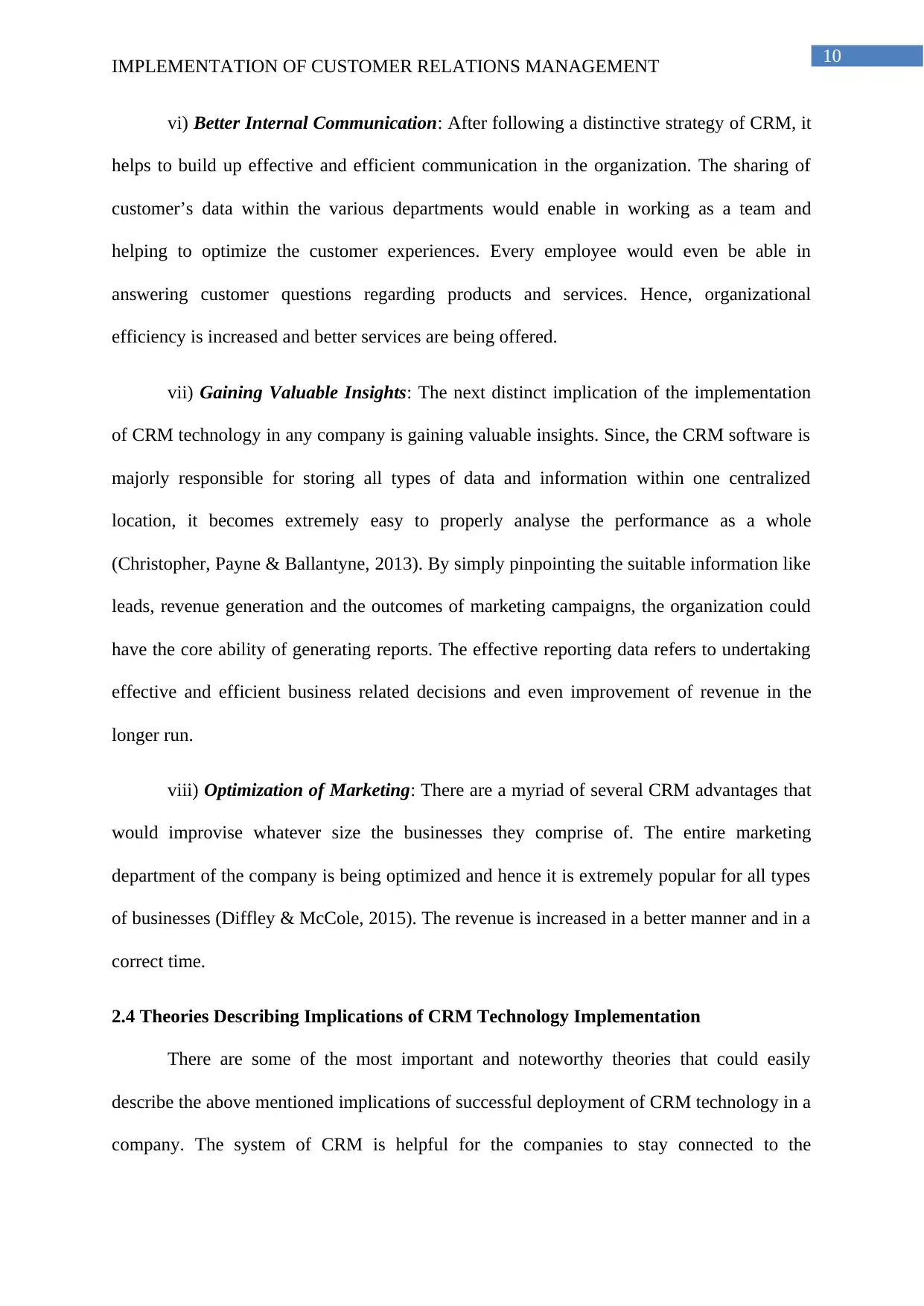
10
IMPLEMENTATION OF CUSTOMER RELATIONS MANAGEMENT
vi) Better Internal Communication: After following a distinctive strategy of CRM, it
helps to build up effective and efficient communication in the organization. The sharing of
customer’s data within the various departments would enable in working as a team and
helping to optimize the customer experiences. Every employee would even be able in
answering customer questions regarding products and services. Hence, organizational
efficiency is increased and better services are being offered.
vii) Gaining Valuable Insights: The next distinct implication of the implementation
of CRM technology in any company is gaining valuable insights. Since, the CRM software is
majorly responsible for storing all types of data and information within one centralized
location, it becomes extremely easy to properly analyse the performance as a whole
(Christopher, Payne & Ballantyne, 2013). By simply pinpointing the suitable information like
leads, revenue generation and the outcomes of marketing campaigns, the organization could
have the core ability of generating reports. The effective reporting data refers to undertaking
effective and efficient business related decisions and even improvement of revenue in the
longer run.
viii) Optimization of Marketing: There are a myriad of several CRM advantages that
would improvise whatever size the businesses they comprise of. The entire marketing
department of the company is being optimized and hence it is extremely popular for all types
of businesses (Diffley & McCole, 2015). The revenue is increased in a better manner and in a
correct time.
2.4 Theories Describing Implications of CRM Technology Implementation
There are some of the most important and noteworthy theories that could easily
describe the above mentioned implications of successful deployment of CRM technology in a
company. The system of CRM is helpful for the companies to stay connected to the
IMPLEMENTATION OF CUSTOMER RELATIONS MANAGEMENT
vi) Better Internal Communication: After following a distinctive strategy of CRM, it
helps to build up effective and efficient communication in the organization. The sharing of
customer’s data within the various departments would enable in working as a team and
helping to optimize the customer experiences. Every employee would even be able in
answering customer questions regarding products and services. Hence, organizational
efficiency is increased and better services are being offered.
vii) Gaining Valuable Insights: The next distinct implication of the implementation
of CRM technology in any company is gaining valuable insights. Since, the CRM software is
majorly responsible for storing all types of data and information within one centralized
location, it becomes extremely easy to properly analyse the performance as a whole
(Christopher, Payne & Ballantyne, 2013). By simply pinpointing the suitable information like
leads, revenue generation and the outcomes of marketing campaigns, the organization could
have the core ability of generating reports. The effective reporting data refers to undertaking
effective and efficient business related decisions and even improvement of revenue in the
longer run.
viii) Optimization of Marketing: There are a myriad of several CRM advantages that
would improvise whatever size the businesses they comprise of. The entire marketing
department of the company is being optimized and hence it is extremely popular for all types
of businesses (Diffley & McCole, 2015). The revenue is increased in a better manner and in a
correct time.
2.4 Theories Describing Implications of CRM Technology Implementation
There are some of the most important and noteworthy theories that could easily
describe the above mentioned implications of successful deployment of CRM technology in a
company. The system of CRM is helpful for the companies to stay connected to the

11
IMPLEMENTATION OF CUSTOMER RELATIONS MANAGEMENT
customers, improving profitability and streamlining processes (Lam, Cheung & Lau, 2013).
There are three distinctive aspects of customer relations management, which are CRM as
technology, CRM as a strategy and CRM as a process. CRM as technology refers to the
technology product, usually within the cloud that the respective teams utilize for recording,
reporting as well as analysing the interactions within users and organizations. It is even
termed as the customer relations management system and solution (Abedin, 2016). The
customer relations management software even records the contact information of customers
and it even automatically pull in any other information like current news regarding the
activity of the organization and it could also store the details like the personal preference on
communications of client.
It also organizes the information for providing a completed record of organizations
and individuals for making the customer’s relationship understand in a better manner. One of
the major aspect of this customer relations management approach would be that the CRM
systems could compile data from a distinct range of various communication channels with
inclusion of social media, electronic mails, marketing materials, organizational website and
many more (Arman, 2014). With the help of this approach of customer relations management
as well as the systems utilized for facilitating it and the businesses hence can learn more
regarding the target audiences and how best the needs are to be needed. It is the proper
combination of technologies, strategies and practices, which the organizations utilize for
managing as well as analysing the customers’ interactions and data in the entire life cycle of
customer with the major objective to improvise the relations of customer services and even
for assisting in the customer retention (Tzokas et al., 2015). These types of systems could
even provide customer facing staff detailed data over the personal information of customers
as well as concerns.
IMPLEMENTATION OF CUSTOMER RELATIONS MANAGEMENT
customers, improving profitability and streamlining processes (Lam, Cheung & Lau, 2013).
There are three distinctive aspects of customer relations management, which are CRM as
technology, CRM as a strategy and CRM as a process. CRM as technology refers to the
technology product, usually within the cloud that the respective teams utilize for recording,
reporting as well as analysing the interactions within users and organizations. It is even
termed as the customer relations management system and solution (Abedin, 2016). The
customer relations management software even records the contact information of customers
and it even automatically pull in any other information like current news regarding the
activity of the organization and it could also store the details like the personal preference on
communications of client.
It also organizes the information for providing a completed record of organizations
and individuals for making the customer’s relationship understand in a better manner. One of
the major aspect of this customer relations management approach would be that the CRM
systems could compile data from a distinct range of various communication channels with
inclusion of social media, electronic mails, marketing materials, organizational website and
many more (Arman, 2014). With the help of this approach of customer relations management
as well as the systems utilized for facilitating it and the businesses hence can learn more
regarding the target audiences and how best the needs are to be needed. It is the proper
combination of technologies, strategies and practices, which the organizations utilize for
managing as well as analysing the customers’ interactions and data in the entire life cycle of
customer with the major objective to improvise the relations of customer services and even
for assisting in the customer retention (Tzokas et al., 2015). These types of systems could
even provide customer facing staff detailed data over the personal information of customers
as well as concerns.
⊘ This is a preview!⊘
Do you want full access?
Subscribe today to unlock all pages.

Trusted by 1+ million students worldwide
1 out of 18
Related Documents
Your All-in-One AI-Powered Toolkit for Academic Success.
+13062052269
info@desklib.com
Available 24*7 on WhatsApp / Email
![[object Object]](/_next/static/media/star-bottom.7253800d.svg)
Unlock your academic potential
Copyright © 2020–2025 A2Z Services. All Rights Reserved. Developed and managed by ZUCOL.




